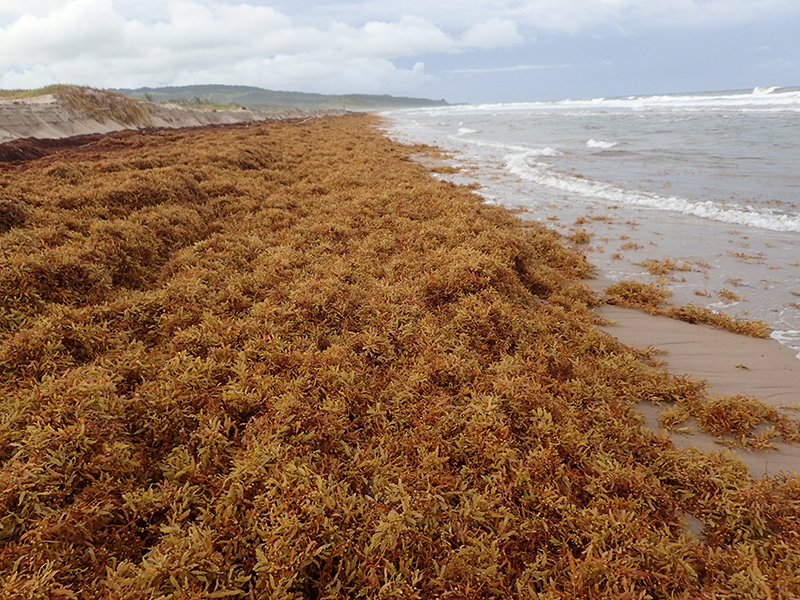
Pelagic sargassum on the East Coast of Barbados – credit H. Oxenford
If you hit the beach recently in the Caribbean or Gulf of Mexico, you may have encountered piles of stinky seaweed.
Sargassum is floating algae that normally circulates throughout the Gulf and North Atlantic, collecting in the latter to form the one thousand-by-three thousand mile Sargasso Sea. In recent years, however, it has shown up in larger-than-normal quantities, called blooms, and at unexpected locations. Blooms occurred in 2011, 2014, and 2015.
Now the algae are at it again. In June, satellite photos detected more than 1,000 square miles of Sargassum in the Caribbean — three times larger than the previous record bloom in 2015, according to the University of South Florida’s Optical Oceanography Laboratory. Researchers at the University of Southern Mississippi, University of the West Indies and the United Nation’s Food and Agriculture Organization office in Barbados who studied the phenomenon suspect much of it may have come not from the Sargasso Sea but a region south of it, between the north equatorial current and the equator.
The reason for this algae reproduction run amok remains unclear, but Jim Franks at USM’s Gulf Coast Research Laboratory says possible causes include ocean pollution and the effects of climate change – for example, warmer surface water temperatures and increased rainfall that washed high levels of nutrients into the sea.
Warm water and plenty of nutrients are the Sargassum equivalent of wine and candlelight – not as romantic, but with more impressive results. These algae reproduce asexually by fragmentation; when wind, waves, animals or boats break up the floating mats, small pieces grow into larger ones. Given the right conditions, a fragment of Sargassum can become acres of the stuff.
The genus Sargassum includes about 150 species of algae that float on the surface of the ocean. Those common in the Gulf and western Atlantic are Sargassum natans and Sargassum fluitans. They form mats that provide food, refuge, breeding grounds and nursery habitat for an array of marine life from fish to sea turtles and birds. Its role as a nursery for commercially important fish such as mahi-mahi and amberjacks earned Sargassum designation as Essential Fish Habitat. After a few years, mats lose their buoyancy and sink to the bottom of the ocean, becoming food for creatures in the deep. Washed ashore by wind and currents, the algae add nutrients to the beach ecosystem and help build and strengthen dunes.
Blooms, however, do more than just gross-out beach-goers. Piles of seaweed on the beach can trap sea turtle hatchlings and thicker-than-normal rafts of it on the water can block needed sunlight from coral reefs. Caribbean fishermen report local flying fish disappearing from affected areas. Thick accumulations can entangle fishing gear and block water intake on fishing boat motors.
Scientists already perplexed by changes in the amount and location of Sargassum have an additional mystery on their hands: recent blooms contain significant quantities of a variant of S. natans not typically seen in the Caribbean and North Atlantic. Perhaps it finds the warm water and nutrients just too hard to resist.
